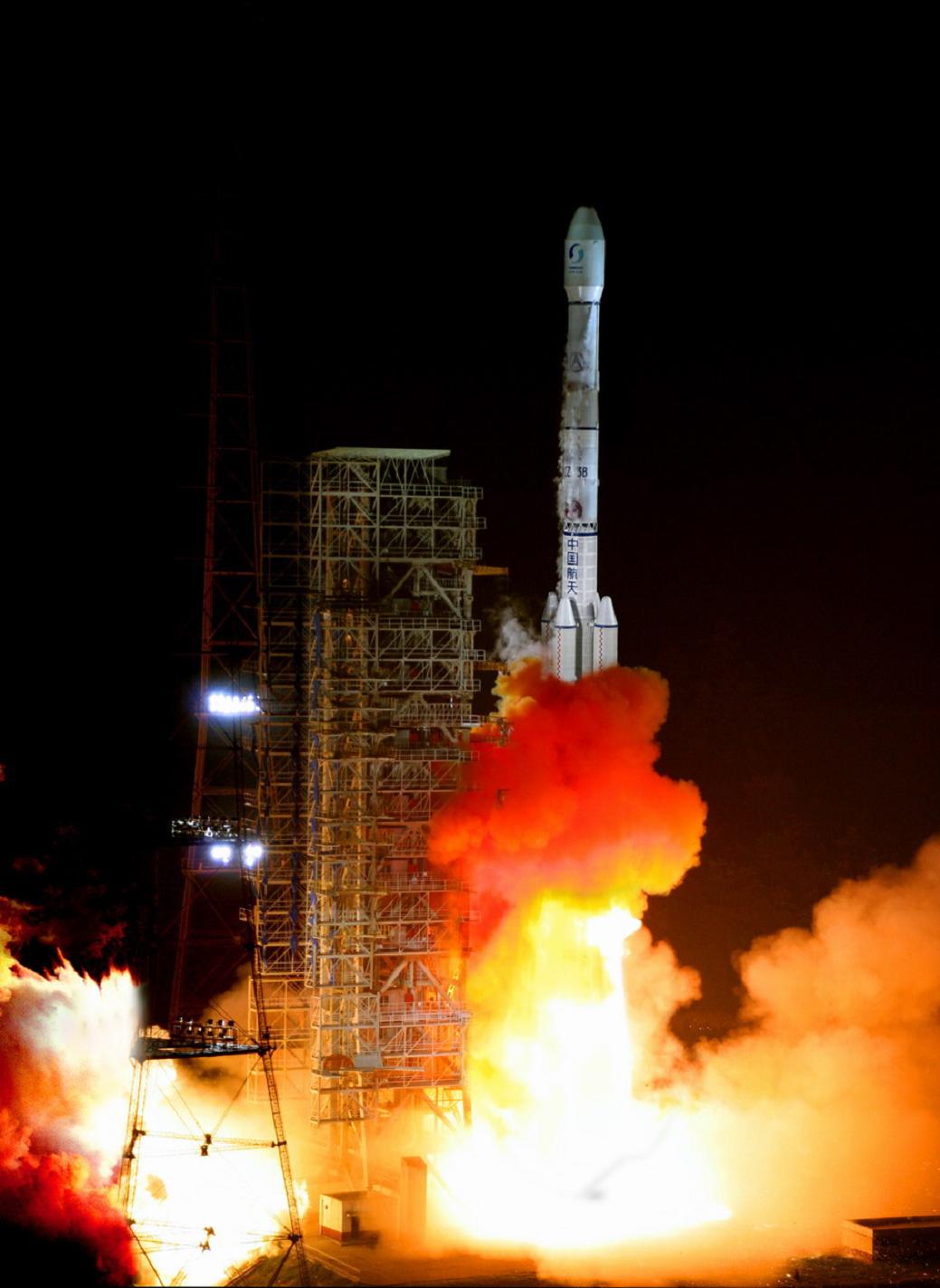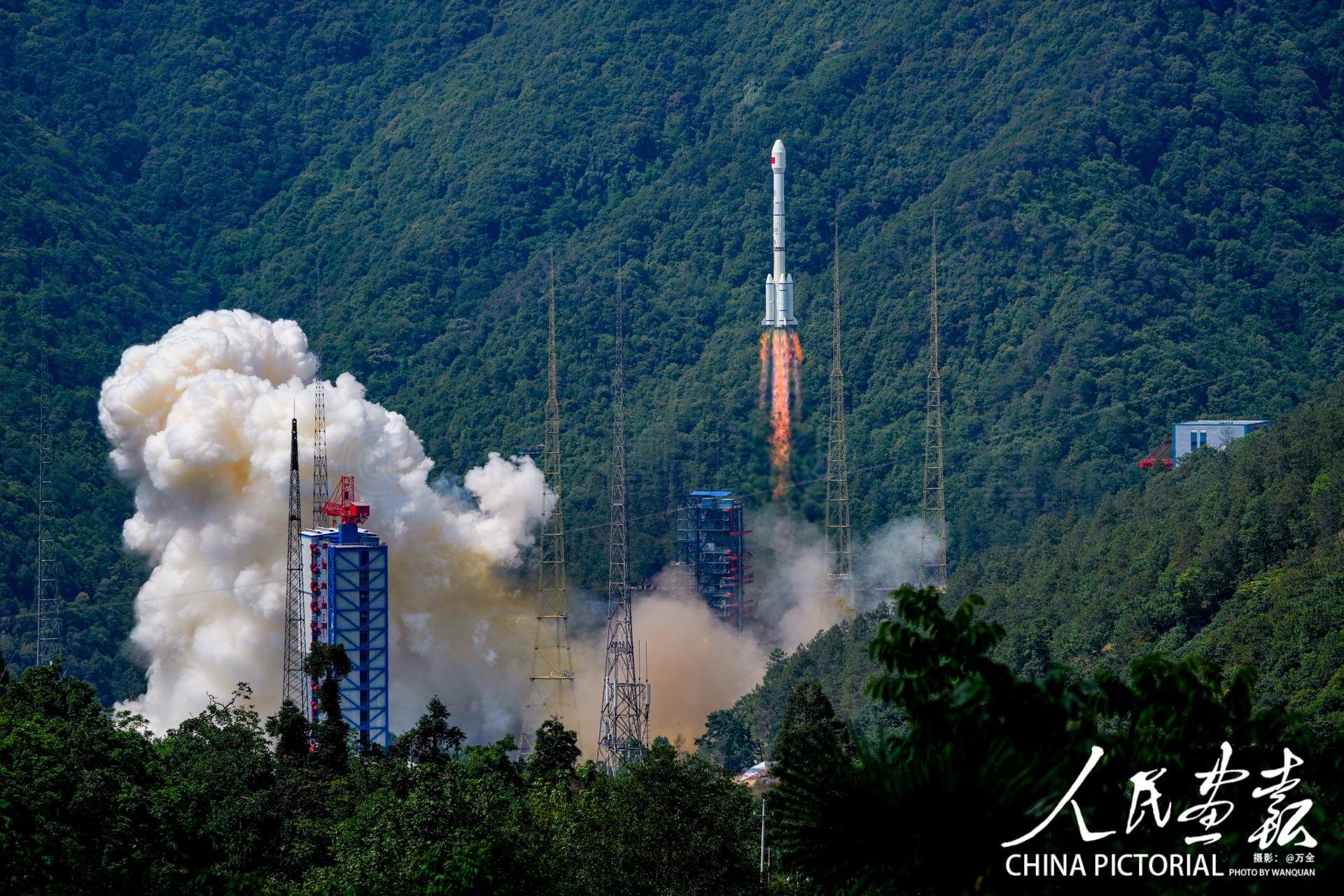
Long March 3B
ActiveChina Aerospace Science and Technology Corporation (CASC)
Feb. 14, 1996
Description
The Long March 3B is a Chinese orbital carrier rocket. Introduced in 1996, it is launched from Launch Area 2 and 3 at the Xichang Satellite Launch Center in Sichuan. A three-stage rocket with four strap-on liquid rocket boosters, it is currently the most powerful member of the Long March rocket family and the heaviest of the Long March 3 rocket family, and is mainly used to place communications satellites into geosynchronous orbits.
Specifications
-
Max Stage
3 -
Length
54.8 m -
Diameter
3.35 m -
Fairing Diameter
― -
Launch Mass
426.0 T -
Thrust
5923.0 kN
Family
-
Name
Long March 3B -
Family
― -
Variant
B -
Alias
― -
Full Name
Long March 3B
Payload Capacity
-
Launch Cost
$70000000 -
Low Earth Orbit
11500.0 kg -
Geostationary Transfer
Orbit
5100.0 kg -
Direct Geostationary
2000.0 kg -
Sun-Synchronous Capacity
―
China Aerospace Science and Technology Corporation
Government
Chairman & President: Lei Fanpei
CASC 1999The China Aerospace Science and Technology Corporation (CASC) is the main contractor for the Chinese space program. It is state-owned and has a number of subordinate entities which design, develop and manufacture a range of spacecraft, launch vehicles, strategic and tactical missile systems, and ground equipment. It was officially established in July 1999 as part of a Chinese government reform drive, having previously been one part of the former China Aerospace Corporation. Various incarnations of the program date back to 1956.
Long March 3B/E | Beidou-3 G4
China Aerospace Science and Technology Corporation | ChinaXichang Satellite Launch Center, People's Republic of China
May 17, 2023, 2:49 a.m.
Status: Launch Successful
Mission:
This satellite is a part of the geostationary component of the 3rd phase of the Chinese Beidou (Compass) satellite navigation system. It features a phased array antenna for navigation signals and a laser retroreflector and additionally deployable S/L-band and C-band antennas.
Geostationary Transfer OrbitLong March 3B | Fengyun-4B
China Aerospace Science and Technology Corporation | ChinaXichang Satellite Launch Center, People's Republic of China
June 2, 2021, 4:17 p.m.
Long March 3B | Beidou-3 G3
China Aerospace Science and Technology Corporation | ChinaXichang Satellite Launch Center, People's Republic of China
June 23, 2020, 1:43 a.m.
Status: Launch Successful
Mission:
This satellite is a part of the geostationary component of the 3rd phase of the Chinese Beidou (Compass) satellite navigation system. It features a phased array antenna for navigation signals and a laser retroreflector and additionally deployable S/L-band and C-band antennas.
Geostationary Transfer OrbitLong March 3B | Nusantara Dua
China Aerospace Science and Technology Corporation | ChinaXichang Satellite Launch Center, People's Republic of China
April 9, 2020, 11:46 a.m.
Status: Launch Failure
Mission:
Nusantara Dua is a high throughput communications satellite built by CAST for Indonesian satellite operator PT Pasifik Satelit Nusantara. It will replace the Palapa D satellite. Nusantara Dua will provide broadband internet and broadcasting access to users in Indonesia, as well as some regions of Asia-Pacific and Australia.
Geostationary Transfer OrbitLong March 3B | Beidou-3 G2
China Aerospace Science and Technology Corporation | ChinaXichang Satellite Launch Center, People's Republic of China
March 9, 2020, 11:55 a.m.
Status: Launch Successful
Mission:
This satellite is a part of the geostationary component of the 3rd phase of the Chinese Beidou (Compass) satellite navigation system. It features a phased array antenna for navigation signals and a laser retroreflector and additionally deployable S/L-band and C-band antennas.
Geostationary Transfer OrbitLong March 3B | TJS-5 (TJSW-5)
China Aerospace Science and Technology Corporation | ChinaXichang Satellite Launch Center, People's Republic of China
Jan. 7, 2020, 3:20 p.m.
Long March 3B | Zhongxing 2D (Chinasat 2D)
China Aerospace Science and Technology Corporation | ChinaXichang Satellite Launch Center, People's Republic of China
Jan. 10, 2019, 5:11 p.m.
Long March 3B | Beidou-3 G1
China Aerospace Science and Technology Corporation | ChinaXichang Satellite Launch Center, People's Republic of China
Nov. 1, 2018, 3:57 p.m.
Status: Launch Successful
Mission:
This satellite is a part of the geostationary component of the 3rd phase of the Chinese Beidou (Compass) satellite navigation system. It features a phased array antenna for navigation signals and a laser retroreflector and additionally deployable S/L-band and C-band antennas.
Geostationary Transfer OrbitLong March 3B | Shijian-13/Chinasat-16
China Aerospace Science and Technology Corporation | ChinaXichang Satellite Launch Center, People's Republic of China
April 12, 2017, 11:04 a.m.
Status: Launch Successful
Mission:
This is a Chinese experimental geostationary communications satellite. Besides testing the electric propulsion, the satellite is also reported to carry Chinas first high-throughput satellite payload (HTS), with a capacity of 20 GB per second. The satellite is aiming to provide Ka-band satellite broadband and multimedia services. Additionally it is also to conduct space-to-ground laser communications experiments.
Geostationary Transfer OrbitLong March 3B | TJS-2 (TJSW-2)
China Aerospace Science and Technology Corporation | ChinaXichang Satellite Launch Center, People's Republic of China
Jan. 5, 2017, 3:18 p.m.
Long March 3B | Fengyun-4A
China Aerospace Science and Technology Corporation | ChinaXichang Satellite Launch Center, People's Republic of China
Dec. 10, 2016, 4:11 p.m.
Status: Launch Successful
Mission:
Fengyun-4A (also known as FY-4A) is the first unit of the improved meteorological satellites series. Besides its main meteorological mission, it is also capable of solar observations for better space weather monitoring capabilites. The satellite is expected to operate for 5 years.
Geostationary Transfer OrbitLong March 3B | Chang'e 3 & Yutu
China Aerospace Science and Technology Corporation | ChinaXichang Satellite Launch Center, People's Republic of China
Dec. 1, 2013, 5:30 p.m.
Status: Launch Successful
Mission:
Chang'e 3 is an uncrewed lunar exploration mission consisting of a robotic lander and China's first lunar rover Yutu. The main objective of the mission is to achieve China's first soft landing and roving exploration on the Moon, as well as performing lunar-based astronomical observation and studying lunar topography and geology.
Lunar OrbitLong March 3B | Chinasat-10
China Aerospace Science and Technology Corporation | ChinaXichang Satellite Launch Center, People's Republic of China
June 20, 2011, 4:13 p.m.
Long March 3B | Chinasat-6A
China Aerospace Science and Technology Corporation | ChinaXichang Satellite Launch Center, People's Republic of China
Sept. 4, 2010, 4:14 p.m.
Long March 3B | Palapa-D
China Aerospace Science and Technology Corporation | ChinaXichang Satellite Launch Center, People's Republic of China
Aug. 31, 2009, 9:28 a.m.
Long March 3B | Zhongxing 9
China Aerospace Science and Technology Corporation | ChinaXichang Satellite Launch Center, People's Republic of China
June 9, 2008, 12:15 p.m.
Long March 3B | Zhongxing 6B
China Aerospace Science and Technology Corporation | ChinaXichang Satellite Launch Center, People's Republic of China
July 5, 2007, 12:08 p.m.
Long March 3B | Xinnuo 2
China Aerospace Science and Technology Corporation | ChinaXichang Satellite Launch Center, People's Republic of China
Oct. 28, 2006, 4:20 p.m.
Long March 3B | Apstar 6
China Aerospace Science and Technology Corporation | ChinaXichang Satellite Launch Center, People's Republic of China
April 12, 2005, noon
Long March 3B | Xinnuo 1
China Aerospace Science and Technology Corporation | ChinaXichang Satellite Launch Center, People's Republic of China
July 18, 1998, 9:20 a.m.
Long March 3B | Zhongwei 1
China Aerospace Science and Technology Corporation | ChinaXichang Satellite Launch Center, People's Republic of China
May 30, 1998, 10 a.m.
Status: Launch Successful
Mission:
The Zhongwei 1 (Chinastar 1) satellite, an A2100A class comsat built by Lockheed Martin for the China Orient Telecommunications Satellite Co., part of the Chinese telecoms ministry. Zhongwei 1 will serve China, India, Korea and southeast Asia with 18 C-band and 20 Ku-band transponders. It was orbited on a CZ-3B launch vehicle using a supersynchronous transfer orbit.
Geostationary OrbitLong March 3B | Apstar 2R
China Aerospace Science and Technology Corporation | ChinaXichang Satellite Launch Center, People's Republic of China
Oct. 16, 1997, 7:13 p.m.
Status: Launch Successful
Mission:
Space Systems/Loral's (SS/L) Apstar-2R is one of the most powerful spacecraft in Asia-Pacific service. Launched in China in 1997 by APT Satellite Company, Ltd., the satellite offers regional voice, video, and data services to an area large enough to link Europe, Russia, the Middle East, Africa, and the Asia-Pacific region into a broad telecommunications network.
Geostationary OrbitLong March 3B | Agila 2
China Aerospace Science and Technology Corporation | ChinaXichang Satellite Launch Center, People's Republic of China
Aug. 19, 1997, 5:50 p.m.
Status: Launch Successful
Mission:
Agila 2, delivered on orbit in 1997, is the most powerful telecommunications satellite in service in the Asia-Pacific region. The new satellite is a prime example of SS/L's dominance in the emerging domestic and international broadcast satellite market.
Geostationary OrbitLong March 3B/E
Fengyun-4C
Launch Complex 2 (LC-2) - Xichang Satellite Launch Center, People's Republic of ChinaChina's geostationary meteorological satellite program FY-4 (Feng Yun 4) is the second generation of chinese geostationary meteorological satellites.
Long March 8A
SatNet LEO Group 17
Commercial LC-1 - Wenchang Space Launch Site, People's Republic of ChinaA batch of 9 Low Earth Orbit communication satellites for the Chinese state owned SatNet constellation operated by the China Satellite Network Group.…
Soyuz 2.1a
Obzor-R No.1
43/4 (43R) - Plesetsk Cosmodrome, Russian FederationNote: Assignment of payloads to this launch is uncertain. The Russian Obzor-R satellite is a planned X-band radar earth observation satellite desi…
LVM-3 (GSLV Mk III)
BlueBird Block 2 #1
Satish Dhawan Space Centre Second Launch Pad - Satish Dhawan Space Centre, IndiaAST SpaceMobile’s Block 2 BlueBird satellites are designed to deliver up to 10 times the bandwidth capacity of the BlueBird Block 1 satellites, requi…
Long March 12A
Demo Flight
Long March 12A Pad - Jiuquan Satellite Launch Center, People's Republic of ChinaFirst test launch of CASC/SAST’s Long March 12A rocket, with a dummy payload. The rocket’s 1st stage attempted to land on a landing pad about 300 km …


